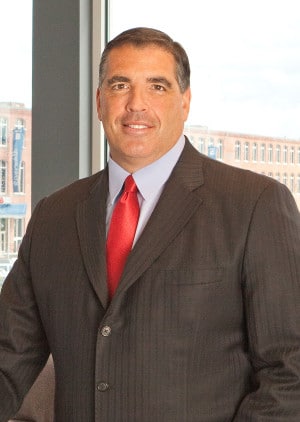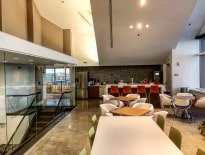Sal Lupoli
Title: CEO and Founder, Lupoli Cos.
Age: 51
Experience: 29 years
After redeveloping former mill properties in Lowell and Lawrence, Sal Lupoli is pursuing ground-up development in Andover and Haverhill. The founder of the Sal’s Pizza and Salvatore’s restaurant chains’ latest venture is a proposed hotel, 200,000 square feet of commercial space and 225 units of 55-and-over housing at 146 Dascomb Road in Andover. Lupoli also is nearing groundbreaking on a 10-story office and residential tower in downtown Haverhill and converting the former Thorndike Mill next to Lowell’s MBTA commuter rail station into 67 market-rate apartments.
Q: What’s the current buildout at Riverwalk in Lawrence?
A: When we first started in 2003, I went to the city council and said this was a 20-year vision for 1.2 million square feet. We’re all the way to the fourth phase and closing in on 3.3 million square feet. By the end of December we’ll be opening up an additional 45 residential units, and 25 are preleased. That will bring us up to 262 units at Riverwalk Lofts. As we build out the commercial space, on a parallel basis we’re opening up the apartments because we know that people want to live where they work. Ten to 15 percent of the units are (occupied by) people who are living right here at Riverwalk.
Q: Do you have an estimated completion date for Thorndike Exchange in Lowell?
A: We took an abandoned mill and it’s about 70 percent finished. We’re going to create 67 market-rate apartments, two restaurants, a wine bar and a cafe and 30,000 square feet of (class A office space). The first move-ins are probably in April or May. We’re building a pedestrian bridge that will connect to the transportation center, so you can take an elevator right down to the tracks.
We’re looking at apartments in Gateway Cities a little different. I’m creating a concierge service in every apartment. We want to create a luxury feel. The concierge will take your groceries, take your laundry, park your car. You don’t find that in Gateway Cities, but we think there’s a huge market for that.
Q: How has the plan for the Dascomb Road project evolved since you first began discussions with the town of Andover?
A: We’re proud to say we can buy real estate and take a long vision approach. Sometimes people will come in and say, “What’s my exit strategy? I want to be in and out of a deal in 36 months and get double-digit returns.” I’m sure you can do that in the Seaport District or Kendall Square, but when you deal with Gateway Cities, you need to be patient. Andover is not a Gateway City, but we were able to purchase 16 acres along I-93 at an interchange. We’re coming to the point where we’re looking forward to the permitting for 600,000 square feet including housing, office, hotel and retail and it’s positioned perfectly. It’s the last piece of real estate in Andover before you cross over into Tewksbury.
Right now we’re trying to permit 225 housing units in Andover. What’s so special about this? Andover has a huge need for 55-and-over housing. It’s one of the most affluent communities and the empty-nesters are trying to capture the equity in a home they purchased 25 years ago. That demographic spends the most money, going to restaurants three to four times a week, and that’s why we’re excited to go into this ZIP code.
Q: Downtown Haverhill recently saw its first major new commercial development with the completion of the 176,000-square-foot Harbor Place. What’s the vision for The Heights, your mixed-use building planned for 192 Merrimack St.?
A: That’s probably one of my most exciting projects. I want to build on this 8,500-square-foot footprint and go up 10 stories. The first floors are restaurants, job creation, education and incubator space. Floors five through nine would be luxury apartments. The building would skinny down to 7,000 square feet and on the 10th floor would be a restaurant and function space. The building will be 75,000 square feet, and it’s really the image I want to attract other developers into Gateway Cities, to tell them you don’t have to be in the Seaport to build sexy buildings. We have our financing and equity in place. It’s not a big building where it requires multiple banks or investors. Our budget to do the entire project is just over $20 million and that’s within our wheelhouse.
Lupoli’s Five Favorite Things About Gateway Cities:
-
Labor force: In every Gateway City, you will find a cluster of immigrants and a cross-section of people who value their jobs.
-
Structures: You will find buildings that are in excess of 100 years old. Our ancestors did not have the machinery and equipment we do now. They built these amazing buildings brick-by-brick with their own hands.
-
Image: The ability to change the image of these cities. In some instances, you have an opportunity to turn blight into new and bright, right in front of the public’s eyes.
-
Food: In every Gateway City you will find interesting cultures that create food and fabulous flavor that you would only find in other countries.
-
Impact: My most favorite part of being in a Gateway City is the impact that you can have, by being a local developer that creates change in the city. By creating change, you create new taxes and new jobs; that translates to better schools, increased safety and more self-pride. To be able to say that you made a difference in a Gateway City is the same as saying you made a difference in someone’s life.




 |
| 



